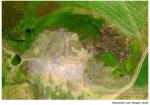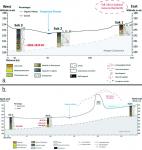Summary (English)
HIMITLIYATA SETTLEMENT MOUND (Krassimir Leshtakov – leshtakov@abv.bg) Clay grain storages Nos. 7, 8 and 9 were explored in the central part of the settlement mound. Debris and a hearth were discovered in Trench M7. Burned debris of mud-bricks and a floor were explored in trench L7. Debris of mud-bricks and an oven were discovered in Trench L6. Hearths Nos. 1 – 2 and an oven were explored in Trench L5, situated within a house whose walls were identified by debris of mud-bricks and postholes, 8 – 15 cm in diameter. Debris of several houses was documented in Trenches L/М3-4. The Early Bronze Age stratum in the Southwestern sector of the settlement mound was c. 3 m thick; it was separated by the lower Late Chalcolithic stratum by a hiatus up to 30 cm thick. Seven or eight occupation layers of the Early Bronze Age 1 and 2 were stratigraphically documented. Due to the peaceful period of existence and the multiple reconstructions of the houses, the exact number of the Early Bronze Age occupation layers could not be specified. At least a dozen of houses were documented in three or four occupation layers. The houses were rectangular with entrances to the south and trenches that accommodated the walls built of mud-bricks supported by wooden posts. There were ovens, hearths, grain storages and clay platforms within the houses. The finds included pottery, bone awls, picks, chisels, spatulas and jewelry, flint artifacts and an awl of arsenic bronze. Carbonized einkorn, emmer, common wheat, barley, lentils, broad bean, common knotgrass, elderberry, oak, alder and hornbeam were identified. The geoarchaeological explorations included five probes drilled around the settlement mound and one probe on the settlement mound. The radiocarbon date from probe core No. 3 was the beginning of the 3rd millennium BC. The radiocarbon date from the earliest anthropogenic layer situated above the Holocene paleo-earth, which was related to the first human occupation on the site, came from the Late Neolithic period (end of the 6th millennium BC). The palynological analysis shows that the area was not densely forested during the entire period of habitation of the settlement mound.
- Krasimir Leshtakov - Department of Archaeology, Sofia University St Kliment Ohridski
Director
- Krasimir Leshtakov - Department of Archaeology, Sofia University St Kliment Ohridski
Team
Research Body
- Sofia University St. Kliment Ohridski






![Download [PDF]](/excavation/skins/fasti/images/results/download_sml.png)

